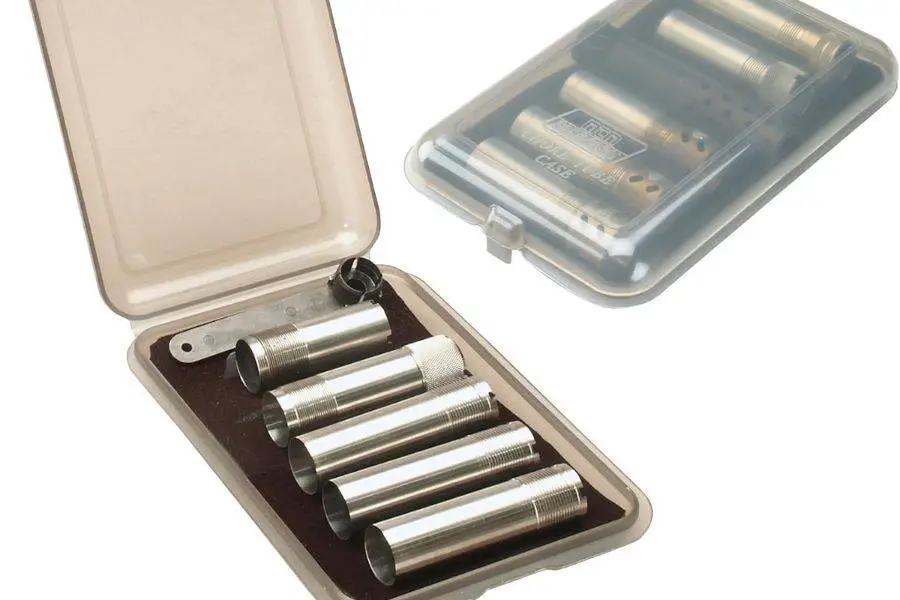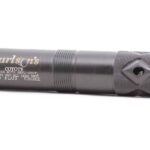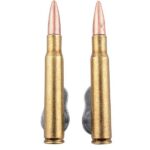Table of Contents
Trap shooting is a popular and challenging sport that requires precision, control, and a deep understanding of your equipment.

This shotgun-based discipline demands competitors to hit clay targets flung into the air at high speeds.
Success in trap shooting depends on several factors, not least of which is the shooter’s choice of choke.
The choke of a shotgun controls the spread of the shot, thereby influencing the accuracy and range of the shot.
Choosing the right choke can significantly improve your performance in trap shooting. It allows for more consistent shooting and higher scores, especially when shooting at longer ranges.
Understanding Shotgun Chokes
In trap shooting, chokes are used to control how much the shot spreads after it leaves the barrel.
A tighter choke will keep the shot together longer, providing a narrower and denser pattern at longer distances.
Conversely, a more open choke allows the shot to spread out more quickly, providing a wider but less dense pattern.
Shotgun chokes come in several types, including Cylinder, Improved Cylinder, Modified, Full, and various specialty chokes.
Each type has its unique characteristics and is suited to different situations and distances in trap shooting.
Cylinder Choke for Trap Shooting
The Cylinder Choke is the most open type of choke, meaning it has the least amount of constriction.
This type of choke doesn’t constrict the shot at all; the shot basically spreads out just as it would if there were no choke installed.
Features of Cylinder Choke
A Cylinder Choke is characterized by its lack of constriction, which allows the shot to spread out quickly once it leaves the barrel.
In essence, it’s as if you’re shooting without a choke. The result is a wide but relatively thin shot pattern.
The spread of the shot is more significant compared to other chokes, which can be beneficial when the targets are close.
This choke is often used for shooting at close range or in situations where a widespread is desired. The shot coverage is broad but not particularly dense.
This means that while the shot will cover a large area, there may not be as many pellets in any given area compared to a tighter choke.
Situations Favoring Cylinder Choke
The Cylinder Choke is generally not the first choice for trap shooting because trap shooting typically involves longer distances where a denser, more focused shot pattern would be beneficial.
However, it could be useful in certain scenarios.
For example, beginners who are still learning to aim accurately may find a Cylinder Choke helpful due to its wider spread.
It provides a larger margin for error, increasing the chances of hitting the target even if the aim isn’t perfect.
Additionally, some forms of trap shooting, like the “report pair” in Sporting Clays, might involve closer targets where a Cylinder Choke could be effective.
Modified Choke for Trap Shooting
The Modified Choke is a popular and versatile choice for trap shooting, providing a balance between shot density and spread.
This choke is characterized by a medium degree of constriction, resulting in a tighter shot pattern compared to more open chokes like the Cylinder or Improved Cylinder.
Key Aspects of Modified Choke
A Modified Choke has a moderate constriction that keeps the shot together for a longer period before it begins to spread.
This results in a denser and more focused shot pattern at medium to long ranges. The shot pattern is typically 60% of the total pellets in a 30-inch circle at 40 yards.
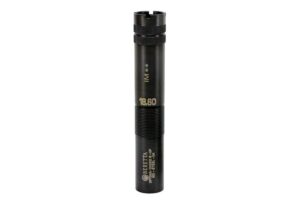
This choke’s effectiveness stems from its ability to provide a denser and more evenly spread shot pattern at typical trap shooting distances.
The result is a higher likelihood of breaking clay targets as they are launched into the air.
In terms of versatility, the Modified Choke strikes a balance between the openness of a Cylinder or Improved Cylinder choke and the tight constriction of a Full Choke.
It gives shooters a wider margin for error than a Full Choke, but with a denser shot pattern than an Improved Cylinder or Cylinder Choke.
Conditions Benefiting from Modified Choke
Modified Chokes are often favored in trap shooting due to their versatility and effectiveness at longer ranges.
They are particularly useful when targets are released at varying angles and distances, a common occurrence in many trap shooting events.
For example, in American Trap, where targets are released away from the shooter at varying angles, a Modified Choke can provide a good balance of shot spread and density.
It allows the shooter to effectively engage targets at varying distances and angles, increasing their chances of scoring hits.
Moreover, a Modified Choke may also be beneficial in windy conditions. The denser shot pattern can help maintain accuracy and effectiveness when the wind might otherwise scatter the shot.
Full Choke for Trap Shooting
The Full Choke is known for its high degree of constriction, which makes it an excellent choice for trap shooting, particularly at longer ranges.
It’s characterized by a tight shot pattern that increases accuracy and shot density at greater distances.
Unique Attributes of Full Choke
A Full Choke has more constriction than other standard chokes like Cylinder, Improved Cylinder, or Modified.
This constriction keeps the shot together for a longer period after leaving the barrel, resulting in a very dense and narrow shot pattern.
Typically, a Full Choke will place approximately 70% of the total pellets in a 30-inch circle at 40 yards.
This high concentration of pellets makes the Full Choke ideal for situations where precision and power are required over longer distances.
The Full Choke is generally the choke of choice for trap shooters who need to shoot targets at longer ranges.
The tight and dense shot pattern allows for fewer stray pellets and a higher likelihood of breaking clays even at greater distances.
Instances Where Full Choke Excels
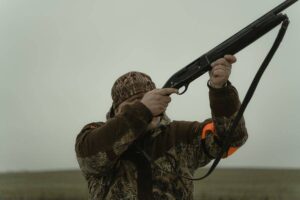
Full Chokes are often used in trap shooting when maximum range and pattern density are required.
They’re particularly effective for the most challenging stations on a trap field, where the targets are farthest away.
In disciplines like American Trap or Olympic Trap, where targets are launched at high speeds and often at significant distances, the Full Choke can provide a distinct advantage.
Its ability to maintain a tight, dense shot pattern even at extended ranges can increase the likelihood of hitting and breaking the clay target.
Moreover, Full Chokes can be beneficial in windy conditions. The denser shot pattern can help maintain accuracy and effectiveness when the wind might otherwise scatter the shot.
Specialty Chokes for Trap Shooting
Specialty chokes, such as Extra Full or Turkey Chokes, provide even greater constriction than Full Chokes. These chokes are designed to deliver extremely tight and dense shot patterns at long ranges.
While not commonly used in standard trap shooting, specialty chokes might come into play in specific situations or variants of the sport.
For instance, they might be used when shooting at extreme ranges or when very high scores are necessary to win.
Conclusion
This article has provided an overview of the various choke options available for trap shooting, from the wide-spreading Cylinder Choke to the tight-patterned Full and specialty chokes.
Remember, the best choke for trap shooting is the one that allows you to hit the most targets consistently.
By understanding how different chokes affect your shot pattern and testing them in practice, you can find the choke that best suits your needs and helps you excel in the sport of trap shooting.

